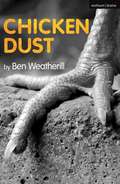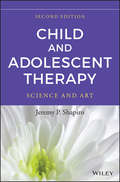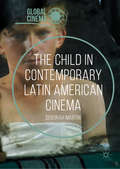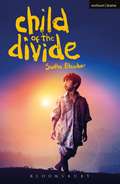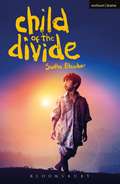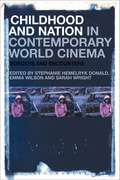- Table View
- List View
Chick Flicks: Contemporary Women at the Movies
by Suzanne Ferriss Mallory YoungFrom An Affair to Remember to Legally Blonde, "chick flicks" have long been both championed and vilified by women and men, scholars and popular audiences. Like other forms of "chick culture," which the editors define as a group of mostly American and British popular culture media forms focused primarily on twenty- to thirtysomething, middle-class—and frequently college-educated—women, chick flicks have been accused of reinscribing traditional attitudes and reactionary roles for women. On the other hand, they have been embraced as pleasurable and potentially liberating entertainments, assisting women in negotiating the challenges of contemporary life. A companion to the successful anthology Chick Lit: The New Woman’s Fiction, this edited volume consists of 11 original essays, prefaced by an introduction situating chick flicks within the larger context of chick culture as well as women’s cinema. The essays consider chick flicks from a variety of angles, touching on issues of film history, female sexuality (heterosexual and homosexual), femininity, female friendship, age, race, ethnicity, class, consumerism, spectatorship, pleasure and gender definition. An afterword by feminist film theorist Karen Hollinger considers the chick flick’s transformation from the woman’s films of the ’40s to the friendship films of the ’80s and those of the "return to the classics" trend of the ’90s, while highlighting the value of the volume’s contributions to contemporary debates and sketching possibilities for further study.
Chicken Dust (Modern Plays)
by Ben WeatherillOh this ain't a farm. This is a loading dock. No such things as farms anymore, not around here.A chicken farm in rural England. New boy Tim has just arrived for his first shift. The job is pretty simple: grab chickens seven at a time by their legs and ram them into cages for shipping. All of this in the dark, stomping around in ankle-deep chicken shit, muck and mud. Tim's teammates are old-timers, with cigarettes dangling from their lips and pantyhose up their arms to protect their skin. Feathers cling to clothes. This band of survivors doesn't want much: just to stay in the countryside, catch the chickens, and earn the best living they can.But the chickens are dying, rotting from the inside-out like hot fruit just hours after they arrive. As disease spreads and pressure mounts, enter Oscar, the meticulous poultry inspector . . .A hard-hitting exploration of the human cost of our enormous appetite for cheap meat.Winner of the Curve Leicester's Playwriting Competition and first seen as a staged reading at the Finborough Theatre's annual Vibrant: A Festival of Finborough Playwrights, Chicken Dust marks the full-length debut of a new playwright. It received its world premiere at the Finborough Theatre on 1 March 2015.
Chicken Dust (Modern Plays #6)
by Ben WeatherillOh this ain't a farm. This is a loading dock. No such things as farms anymore, not around here.A chicken farm in rural England. New boy Tim has just arrived for his first shift. The job is pretty simple: grab chickens seven at a time by their legs and ram them into cages for shipping. All of this in the dark, stomping around in ankle-deep chicken shit, muck and mud. Tim's teammates are old-timers, with cigarettes dangling from their lips and pantyhose up their arms to protect their skin. Feathers cling to clothes. This band of survivors doesn't want much: just to stay in the countryside, catch the chickens, and earn the best living they can.But the chickens are dying, rotting from the inside-out like hot fruit just hours after they arrive. As disease spreads and pressure mounts, enter Oscar, the meticulous poultry inspector . . .A hard-hitting exploration of the human cost of our enormous appetite for cheap meat.Winner of the Curve Leicester's Playwriting Competition and first seen as a staged reading at the Finborough Theatre's annual Vibrant: A Festival of Finborough Playwrights, Chicken Dust marks the full-length debut of a new playwright. It received its world premiere at the Finborough Theatre on 1 March 2015.
The Chicken Sisters: a feel-good summer read of sibling rivalry, family history and fried chicken
by KJ Dell’AntoniaTHREE GENERATIONS. TWO CHICKEN SHACKS. ONE RECIPE FOR DISASTER.In tiny Merinac, Kansas, Chicken Mimi's and Chicken Frannie's have spent a century vying to serve up the best fried chicken in the state - and the legendary feud between their respective owners, the Moores and the Pogociellos, has lasted just as long. No one feels the impact more than thirty-five-year-old widow Amanda Moore, who grew up working for her mom at Mimi's before scandalously marrying Frank Pogociello and changing sides to work at Frannie's. Tired of being caught in the middle, Amanda sends an SOS to Food Wars, the reality TV restaurant competition that promises $100,000 to the winner. But in doing so, she launches both families out of the frying pan and directly into the fire. The last thing Brooklyn-based organisational guru Mae Moore, Amanda's sister, wants is to go home to Kansas. But when her career implodes, Food Wars becomes her chance to step back into the limelight. Mae is certain she can make the fading Mimi's look good - even if that pits her against Amanda and Frannie's. With a greedy producer stoking the flames, their friendly rivalry quickly turns into a game of chicken. Yet when family secrets become public knowledge, the sisters must choose: will they fight with each other, or for their heritage? After all, all's fair in love, and war, and chicken . . .'It's like the comfort food of novels: warm, memorable and wholly original. I loved it' Laura Zigman, author of SEPARATION ANXIETY
Chief Engineer: The Man Who Built the Brooklyn Bridge
by Erica WagnerA New Statesman Book of the Year for 2017His father conceived of the Brooklyn Bridge, but it was Washington Roebling who built this iconic feat of human engineering after his father's tragic death. It has stood for more than 130 years and is now as much a part of New York as the Statue of Liberty or the Empire State Building. Yet, as recognisable as the bridge is, its builder is too often forgotten. The Chief Engineer is a brilliant examination of the life of one of America's most distinguished engineers. Roebling's experience as an engineer building bridges in the Union Army during the civil War has never before been documented, and played a central role in the bridge that links Brooklyn and Manhattan. The Brooklyn Bridge took fourteen dramatic years to complete, and the personal story that lay behind that construction is told here for the first time. The Chief Engineer is an engaging portrait of a brilliant and driven man, and of the era in which he lived. Meticulously researched, and written with revealing archival material only recently uncovered, including Washington Roebling's own memoir that was previously thought to be lost to history, in The Chief Engineer Erica Wagner relates the fascinating history of the bridge and its maker.
Chief Engineer: Washington Roebling, The Man Who Built the Brooklyn Bridge
by Erica Wagner"A welcome tribute to the persistence, precision and humanity of Washington Roebling and a love-song for the mighty New York bridge he built." -The Wall Street Journal Chief Engineer is the first full biography of a crucial figure in the American story-Washington Roebling, builder of the Brooklyn Bridge. One of America's most iconic and recognizable structures, the Brooklyn Bridge is as much a part of New York as the Statue of Liberty or the Empire State Building. Yet its distinguished builder is too often forgotten-and his life is of interest far beyond his chosen field. It is the story of immigrants, the frontier, the Civil War, the making of the modern world, and a man whose long life modeled courage in the face of extraordinary adversity.Chief Engineer is enriched by Roebling's own eloquent voice, unveiled in his recently discovered memoir, previously thought lost to history. The memoir reveals that his father John-a renowned engineer who made his life in America after humble beginnings in Germany-was a tyrannical presence in Roebling's life. It also documents Roebling's time as a young man in the Union Army, when he built bridges that carried soldiers across rivers and saw action in pivotal battles from Antietam to Gettysburg. Safely returned, he married the remarkable Emily Warren Roebling, who would play a crucial role in the construction of the Brooklyn Bridge, Roebling's grandest achievement-but by no means the only one.Elegantly written with a compelling narrative sweep, Chief Engineer introduces Washington Roebling and his era to a new generation of readers.
Chiesa e Stato: Church-State Relations in Italy within the Contemporary Constitutional Framework
by P. Vincent BucciItaly is left out of most contemporary comparative studies of political systems. This omission can be due neither to any intrinsic unimportance of Italy in Europe, nor to the absence of parallel similarities and differ ences - the prerequisites of comparative explanation - between the Italian and other Western political systems. It may be due to the paucity of case studies of Italian politics, upon which comparisons would have to be based. Professor Bucci's book will contribute toward overcoming this scarcity. Not only is Italy under-represented in comparative studies of post war European politics, but there is also a shortage of monographs dealing with particular aspects of Italian politics since the founding of the Republic, especially in English. I hope that Dr. Bucci's work, which is based exclusively upon original Italian sources, signals the beginning of exploration, more systematic than hitherto, of the goldmine for case studies which post-war Italian politics presents to political scientists.
The Chiffon Trenches
by Andre Leon Talley‘Honestly and candidly captures fifty sublime years of fashion’ Manolo Blahnik Discover what truly happens behind the scenes in the world of high fashion in this detailed, storied memoir from style icon, bestselling author and former Vogue creative director André Leon Talley.
Child Actors on the London Stage, Circa 1600: Their Education, Recruitment and Theatrical Success
by Julie AckroydA legal document dated 1600, for a Star Chamber case titled Clifton versus Robinson, details how boys were abducted from London streets and forcibly held in order to train them as actors for the Blackfriars theatre. No adults were seen on-stage in this theatre, which was stocked solely by acting boys, resulting in a satirical and scurrilous method of play presentation. Were the boys specifically targeted for skills they may have possessed which would have been applicable to this type of play presentation? And, was this method of recruitment typical or atypical of Elizabethan theatre? Analysis of the background of the boy subjects of the legal case indicate that several had received grammar-school tuition and, as a result, would have possessed skills in oration and rhetoric. Indeed, a significant number of the grammar schools in London provided regular public disputations and theatrical performances which would have made these boys an attractive proposition for inclusion in a theatrical company. The styles of play-texts which the boys performed and their manner of presenting characters helps to assess why child acting companies were commercially viable and popular. Their portrayal of all roles in a performance; young and old, male and female, clearly demonstrated their versatility and skill in mimicry and the adoption of other personas. Therefore the taking of grammar-school boys for re-training as actors was not opportunistic; their abductions were planned. The theatre owners undertook this method of recruitment as they felt that they were immune from prosecution due to holding royal commissions which they used to recruit boys. However, the Clifton vs. Robinson case clearly demonstrates that a determined parent whose child had been taken could challenge this and demand reparation.
Child and Adolescent Therapy: Science and Art
by Jeremy P. ShapiroComprehensive introduction to the theory and practice of therapy Child and Adolescent Therapy: Science and Art, Second Edition relies on both psychotherapy research and clinical expertise to create a comprehensive guide to evidence-based practice for providers of child and adolescent therapy. It includes explanations of all major theoretical orientations and the techniques associated with each, with application to the major diagnostic categories. This updated Second Edition includes a new chapter on Mindfulness-Based Cognitive-Behavioral Therapies (Dialectical Behavior Therapy and Acceptance and Commitment Therapy), incorporation of recent neuroscience research, instruction in Motivational Interviewing, and guidance in using therapeutic diagrams with young clients. The book models the thought process of expert therapists by describing how the science and art of therapy can be combined to provide a strong basis for treatment planning and clinical decision-making. Theoretical concepts, empirically supported treatments, and best practices are translated into concrete, detailed form, with numerous examples of therapist verbalizations and conversations between counselor and client. Child and Adolescent Therapy: Science and Art, Second Edition: Explains the work of therapists from the ground up, beginning with fundamentals and moving on to advanced theory and technique Covers the major theoretical approaches: behavioral, cognitive, mindfulness-based, psychodynamic, constructivist, and family systems Guides therapists in planning effective treatment strategies with balanced consideration of outcome research, cultural factors, and individual client characteristics Connects treatment planning with the diagnostic characteristics of the major child and adolescent disorders For both students and skilled clinicians looking for new ideas and techniques, Child and Adolescent Therapy: Science and Art, Second Edition offers a thorough, holistic examination of how best to serve young therapy clients.
Child and Adolescent Therapy: Science and Art
by Jeremy P. ShapiroComprehensive introduction to the theory and practice of therapy Child and Adolescent Therapy: Science and Art, Second Edition relies on both psychotherapy research and clinical expertise to create a comprehensive guide to evidence-based practice for providers of child and adolescent therapy. It includes explanations of all major theoretical orientations and the techniques associated with each, with application to the major diagnostic categories. This updated Second Edition includes a new chapter on Mindfulness-Based Cognitive-Behavioral Therapies (Dialectical Behavior Therapy and Acceptance and Commitment Therapy), incorporation of recent neuroscience research, instruction in Motivational Interviewing, and guidance in using therapeutic diagrams with young clients. The book models the thought process of expert therapists by describing how the science and art of therapy can be combined to provide a strong basis for treatment planning and clinical decision-making. Theoretical concepts, empirically supported treatments, and best practices are translated into concrete, detailed form, with numerous examples of therapist verbalizations and conversations between counselor and client. Child and Adolescent Therapy: Science and Art, Second Edition: Explains the work of therapists from the ground up, beginning with fundamentals and moving on to advanced theory and technique Covers the major theoretical approaches: behavioral, cognitive, mindfulness-based, psychodynamic, constructivist, and family systems Guides therapists in planning effective treatment strategies with balanced consideration of outcome research, cultural factors, and individual client characteristics Connects treatment planning with the diagnostic characteristics of the major child and adolescent disorders For both students and skilled clinicians looking for new ideas and techniques, Child and Adolescent Therapy: Science and Art, Second Edition offers a thorough, holistic examination of how best to serve young therapy clients.
The Child in British Cinema
by Matthew SmithThis book argues that over the twentieth and twenty-first centuries, the cinema in Britain became the site on which childhood was projected, examined, and understood. Through an analysis of these projections; via case studies that encompass early cinema, pre and post-war film, and contemporary cinema; this book interprets the child in British cinema as a device through which to reflect upon issues of national culture, race, empire, class, and gender. Beginning with a discussion of early cinematic depictions of the child in Britain, this book examines cultural expressions of nationhood produced via non-commercial cinemas for children. It considers the way cinema encroaches on the moral edification of the child and the ostensible vibrancy and vitality of the British boy in post-war cinema. The author explores the representational and instrumental differences between depictions of boys and girls before extending this discussion to investigate the treatment of migrant, refugee, and immigrant children in British cinema. It ends by recapitulating these arguments through a discussion of internationally successful British blockbuster cinema. The child in this study is a mobile figure, deployed across generic boundaries, throughout the history of British cinema and embodying a range of discourses regarding the health and wellbeing of the nation.
The Child in Cinema
by Karen LuryThis book brings together a host of internationally recognised scholars to provide an interdisciplinary perspective on the representation of the child in cinema. Individual chapters examine how children appear across a broad range of films, including Badlands (1973), Ratcatcher (1999), Boyhood (2014), My Neighbour Totoro (1988), and Howl's Moving Castle (2004). They also consider the depiction of children in non-fiction and non-theatrical films, including the documentaries Être et Avoir (2002) and Capturing the Friedmans (2003), art installations and public information films. Through a close analysis of these films, contributors examine the spaces and places children inhabit and imagine; a concern for children's rights and agency; the affective power of the child as a locus for memory and history; and the complexity and ambiguity of the child figure itself.The essays also argue the global reach of cinema featuring children, including analyses of films from the former Yugoslavia, Brazil and India, as well as exploring the labour of the child both in front of and behind the camera as actors and filmmakers. In doing so, the book provides an in-depth look into the nature of child performance on screen, across a diverse range of cinemas and film-making practices.
The Child in Cinema
by Karen LuryThis book brings together a host of internationally recognised scholars to provide an interdisciplinary perspective on the representation of the child in cinema. Individual chapters examine how children appear across a broad range of films, including Badlands (1973), Ratcatcher (1999), Boyhood (2014), My Neighbour Totoro (1988), and Howl's Moving Castle (2004). They also consider the depiction of children in non-fiction and non-theatrical films, including the documentaries Être et Avoir (2002) and Capturing the Friedmans (2003), art installations and public information films. Through a close analysis of these films, contributors examine the spaces and places children inhabit and imagine; a concern for children's rights and agency; the affective power of the child as a locus for memory and history; and the complexity and ambiguity of the child figure itself.The essays also argue the global reach of cinema featuring children, including analyses of films from the former Yugoslavia, Brazil and India, as well as exploring the labour of the child both in front of and behind the camera as actors and filmmakers. In doing so, the book provides an in-depth look into the nature of child performance on screen, across a diverse range of cinemas and film-making practices.
The Child in Contemporary Latin American Cinema (Global Cinema)
by Deborah MartinWhat is the child for Latin American cinema? This book aims to answer that question, tracing the common tendencies of the representation of the child in the cinema of Latin American countries, and demonstrating the place of the child in the movements, genres and styles that have defined that cinema. Deborah Martin combines theoretical readings of the child in cinema and culture, with discussions of the place of the child in specific national, regional and political contexts, to develop in-depth analyses and establish regional comparisons and trends. She pays particular attention to the narrative and stylistic techniques at play in the creation of the child's perspective, and to ways in which the presence of the child precipitates experiments with film aesthetics. Bringing together fresh readings of well-known films with attention to a range of little-studied works, The Child in Contemporary Latin American Cinema examines films from the recent and contemporary period, focussing on topics such as the death of the child in ‘street child’ films, the role of the child in post-dictatorship filmmaking and the use of child characters to challenge gender and sexual ideologies. The book also aims to place those analyses in a historical context, tracing links with important precursors, and paying attention to the legacy of the child’s figuring in the mid-century movements of melodrama and the New Latin American Cinema.
The Child in Film: Tears, Fears and Fairy Tales (Rutgers Series In Childhood Studies)
by Karen LuryGhastly and ghostly children, 'dirty little white girls', the child as witness and as victim, have always played an important part in the history of cinema, as have child performers themselves. In exploring the disruptive power of the child in films made for an adult audience across popular films, including 'Taxi Driver' and Japanese horror, and 'arthouse' productions like 'Mirror' and 'Pan's Labyrinth', Karen Lury investigates why the figure of the child has such a significant impact on the visual aspects and storytelling potential of cinema. Lury's main argument is that the child as a liminal yet powerful agent has allowed filmmakers to play adventurously with cinema's formal conventions with farreaching consequences. In particular, she reveals how a child's relationship to time allows it to disturb and question conventional masternarratives. She explores too the investment in the child actor and expression of child sexuality, as well as how confining and conservative existing assumptions can be in terms of commonly held beliefs as to who children 'really are'.
Child Labor in the British Victorian Entertainment Industry: 1875–1914 (Palgrave Studies in Theatre and Performance History)
by Dyan ColcloughChild labor greatly contributed to the cultural and economic success of the British Victorian theatrical industry. This book highlights the complexities of the battle for child labor laws, the arguments for the needs of the theatre industry, and the weight of opposition that confronted any attempt to control employers.
Child of the Divide (Modern Plays)
by Sudha BhucharI have a boy. He is across the border, I know he is.A few miles between. The same starsShine on himSummer 1947. Sixteen million people are on the move between India and the newly-formed Pakistan. Amid the violent political upheaval, young Pali's fingers slip from his father's hand, and his destiny changes forever.Lost, dispossessed and alone, Pali is saved by a Muslim family. The boy is given a new home and new family, a new name, a new faith and a new life. But seven years later, his real father returns to claim him and Pali's life is turned upside down again. He is forced to decide who he is: the Hindu boy he was born to be, the Muslim boy he has become, or simply a child of the divide.This edition has been published to mark the 70th anniversary of the partition of India and a new high-profile production originating once again at the Polka Theatre. Sudha Bhuchar's remarkable story of family, identity and belonging set against a fractured landscape is a fictionalised account of real experiences, of families torn apart and of stolen pasts, where friendship and love are found in unexpected places.
Child of the Divide (Modern Plays)
by Sudha BhucharI have a boy. He is across the border, I know he is.A few miles between. The same starsShine on himSummer 1947. Sixteen million people are on the move between India and the newly-formed Pakistan. Amid the violent political upheaval, young Pali's fingers slip from his father's hand, and his destiny changes forever.Lost, dispossessed and alone, Pali is saved by a Muslim family. The boy is given a new home and new family, a new name, a new faith and a new life. But seven years later, his real father returns to claim him and Pali's life is turned upside down again. He is forced to decide who he is: the Hindu boy he was born to be, the Muslim boy he has become, or simply a child of the divide.This edition has been published to mark the 70th anniversary of the partition of India and a new high-profile production originating once again at the Polka Theatre. Sudha Bhuchar's remarkable story of family, identity and belonging set against a fractured landscape is a fictionalised account of real experiences, of families torn apart and of stolen pasts, where friendship and love are found in unexpected places.
Childhood and Nation in Contemporary World Cinema: Borders and Encounters
by Sarah Wright Emma Wilson Stephanie Hemelryk DonaldThe child has existed in cinema since the Lumière Brothers filmed their babies having messy meals in Lyons, but it is only quite recently that scholars have paid serious attention to her/his presence on screen. Scholarly discussion is now of the highest quality and of interest to anyone concerned not only with the extent to which adult cultural conversations invoke the figure of the child, but also to those interested in exploring how film cultures can shift questions of agency and experience in relation to subjectivity. Childhood and Nation in World Cinema recognizes that the range of films and scholarship is now sufficiently extensive to invoke the world cinema mantra of pluri-vocal and pluri-central attention and interpretation. At the same time, the importance of the child in figuring ideas of nationhood is an undiminished tic in adult cultural and social consciousness. Either the child on film provokes claims on the nation or the nation claims the child. Given the waning star of national film studies, and the widely held and serious concerns over the status of the nation as a meaningful cultural unit, the point here is not to assume some extraordinary pre-social geopolitical empathy of child and political entity. Rather, the present collection observes how and why and whether the cinematic child is indeed aligned to concepts of modern nationhood, to concerns of the State, and to geo-political organizational themes and precepts.
Childhood and Nation in Contemporary World Cinema: Borders and Encounters
by Sarah Wright Emma Wilson Stephanie Hemelryk DonaldThe child has existed in cinema since the Lumière Brothers filmed their babies having messy meals in Lyons, but it is only quite recently that scholars have paid serious attention to her/his presence on screen. Scholarly discussion is now of the highest quality and of interest to anyone concerned not only with the extent to which adult cultural conversations invoke the figure of the child, but also to those interested in exploring how film cultures can shift questions of agency and experience in relation to subjectivity. Childhood and Nation in World Cinema recognizes that the range of films and scholarship is now sufficiently extensive to invoke the world cinema mantra of pluri-vocal and pluri-central attention and interpretation. At the same time, the importance of the child in figuring ideas of nationhood is an undiminished tic in adult cultural and social consciousness. Either the child on film provokes claims on the nation or the nation claims the child. Given the waning star of national film studies, and the widely held and serious concerns over the status of the nation as a meaningful cultural unit, the point here is not to assume some extraordinary pre-social geopolitical empathy of child and political entity. Rather, the present collection observes how and why and whether the cinematic child is indeed aligned to concepts of modern nationhood, to concerns of the State, and to geo-political organizational themes and precepts.
Childhood by Design: Toys and the Material Culture of Childhood, 1700-Present (Material Culture of Art and Design)
by Megan Brandow-FallerInformed by the analytical practices of the interdisciplinary 'material turn' and social historical studies of childhood, Childhood By Design: Toys and the Material Culture of Childhood offers new approaches to the material world of childhood and design culture for children. This volume situates toys and design culture for children within broader narratives on history, art, design and the decorative arts, where toy design has traditionally been viewed as an aberration from more serious pursuits. The essays included treat toys not merely as unproblematic reflections of socio-cultural constructions of childhood but consider how design culture actively shaped, commodified and materialized shifting discursive constellations surrounding childhood and children. Focusing on the new array of material objects designed in response to the modern 'invention' of childhood-what we might refer to as objects for a childhood by design-Childhood by Design explores dynamic tensions between theory and practice, discursive constructions and lived experience as embodied in the material culture of childhood. Contributions from and between a variety of disciplinary perspectives (including history, art history, material cultural studies, decorative arts, design history, and childhood studies) are represented – critically linking historical discourses of childhood with close study of material objects and design culture.Chronologically, the volume spans the 18th century, which witnessed the invention of the toy as an educational plaything and a proliferation of new material artifacts designed expressly for children's use; through the 19th-century expansion of factory-based methods of toy production facilitating accuracy in miniaturization and a new vocabulary of design objects coinciding with the recognition of childhood innocence and physical separation within the household; towards the intersection of early 20th-century child-centered pedagogy and modernist approaches to nursery and furniture design; through the changing consumption and sales practices of the postwar period marketing directly to children through television, film and other digital media; and into the present, where the line between the material culture of childhood and adulthood is increasingly blurred.
Childhood by Design: Toys and the Material Culture of Childhood, 1700-Present (Material Culture of Art and Design)
by Megan Brandow-FallerInformed by the analytical practices of the interdisciplinary 'material turn' and social historical studies of childhood, Childhood By Design: Toys and the Material Culture of Childhood offers new approaches to the material world of childhood and design culture for children. This volume situates toys and design culture for children within broader narratives on history, art, design and the decorative arts, where toy design has traditionally been viewed as an aberration from more serious pursuits. The essays included treat toys not merely as unproblematic reflections of socio-cultural constructions of childhood but consider how design culture actively shaped, commodified and materialized shifting discursive constellations surrounding childhood and children. Focusing on the new array of material objects designed in response to the modern 'invention' of childhood-what we might refer to as objects for a childhood by design-Childhood by Design explores dynamic tensions between theory and practice, discursive constructions and lived experience as embodied in the material culture of childhood. Contributions from and between a variety of disciplinary perspectives (including history, art history, material cultural studies, decorative arts, design history, and childhood studies) are represented – critically linking historical discourses of childhood with close study of material objects and design culture.Chronologically, the volume spans the 18th century, which witnessed the invention of the toy as an educational plaything and a proliferation of new material artifacts designed expressly for children's use; through the 19th-century expansion of factory-based methods of toy production facilitating accuracy in miniaturization and a new vocabulary of design objects coinciding with the recognition of childhood innocence and physical separation within the household; towards the intersection of early 20th-century child-centered pedagogy and modernist approaches to nursery and furniture design; through the changing consumption and sales practices of the postwar period marketing directly to children through television, film and other digital media; and into the present, where the line between the material culture of childhood and adulthood is increasingly blurred.
Childhood in Animation: Navigating a Secret World (Routledge Research in Cultural and Media Studies)
by Jane BatkinChildhood in Animation: Navigating a Secret World explores how children are viewed in animated cinema and television and examines the screen spaces that they occupy.The image of the child is often a site of conflict, one that has been captured, preserved, and recollected on screen; but what do these representations tell us about the animated child and how do they compare to their real counterparts? Is childhood simply a metaphor for innocence, or something far more complex that encompasses agency, performance, and othering? Childhood in Animation focuses on key screen characters, such as DJ, Norman, Lilo, the Lost Boys, Marji, Parvana, Bluey, Kirikou, Robyn, Mebh, Cartman and Bart, amongst others, to see how they are represented within worlds of fantasy, separation, horror, politics, and satire, as well as viewing childhood itself through a philosophical, sociological, and global lens. Ultimately, this book navigates the rabbit hole of the ‘elsewhere’ to reveal the secret space of childhood, where anything (and everything) is possible.This volume will be of great interest to scholars and students of animation, childhood studies, film and television studies, and psychology and sociology.
Childhood in Animation: Navigating a Secret World (Routledge Research in Cultural and Media Studies)
by Jane BatkinChildhood in Animation: Navigating a Secret World explores how children are viewed in animated cinema and television and examines the screen spaces that they occupy.The image of the child is often a site of conflict, one that has been captured, preserved, and recollected on screen; but what do these representations tell us about the animated child and how do they compare to their real counterparts? Is childhood simply a metaphor for innocence, or something far more complex that encompasses agency, performance, and othering? Childhood in Animation focuses on key screen characters, such as DJ, Norman, Lilo, the Lost Boys, Marji, Parvana, Bluey, Kirikou, Robyn, Mebh, Cartman and Bart, amongst others, to see how they are represented within worlds of fantasy, separation, horror, politics, and satire, as well as viewing childhood itself through a philosophical, sociological, and global lens. Ultimately, this book navigates the rabbit hole of the ‘elsewhere’ to reveal the secret space of childhood, where anything (and everything) is possible.This volume will be of great interest to scholars and students of animation, childhood studies, film and television studies, and psychology and sociology.

